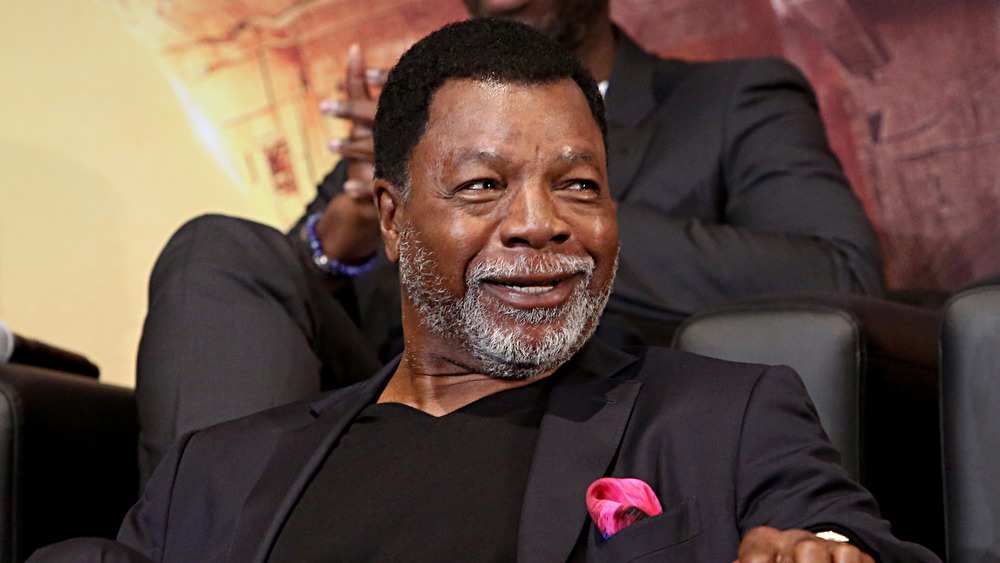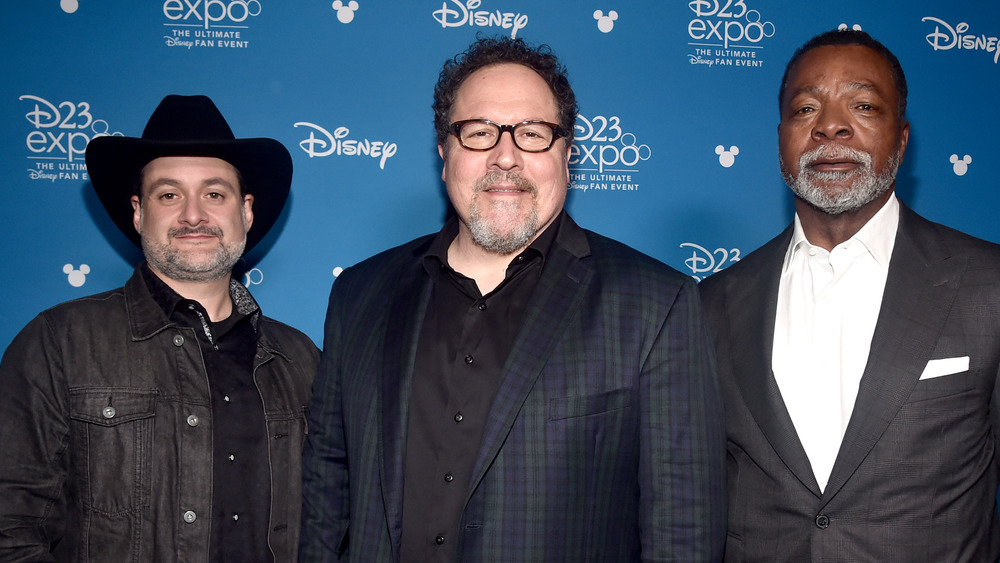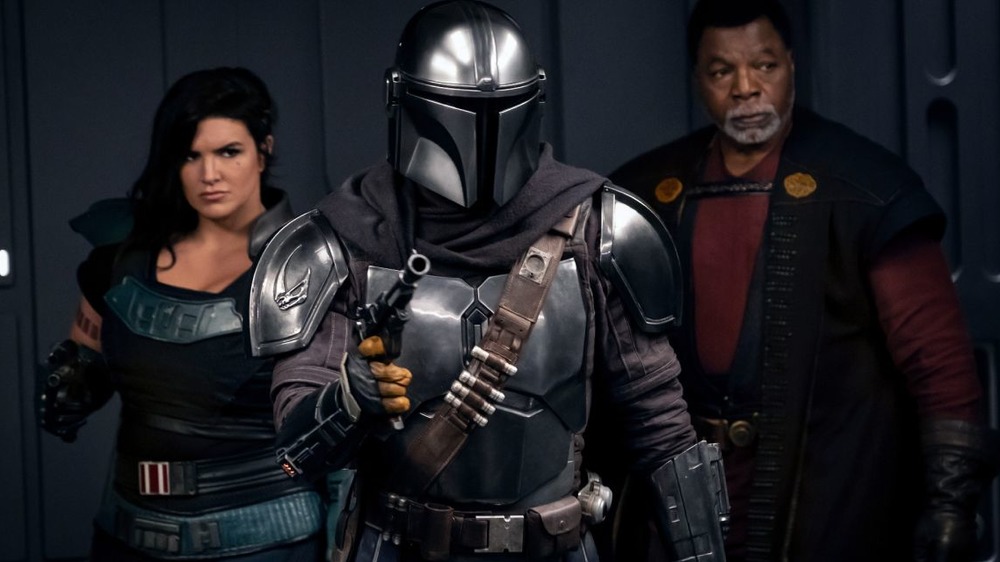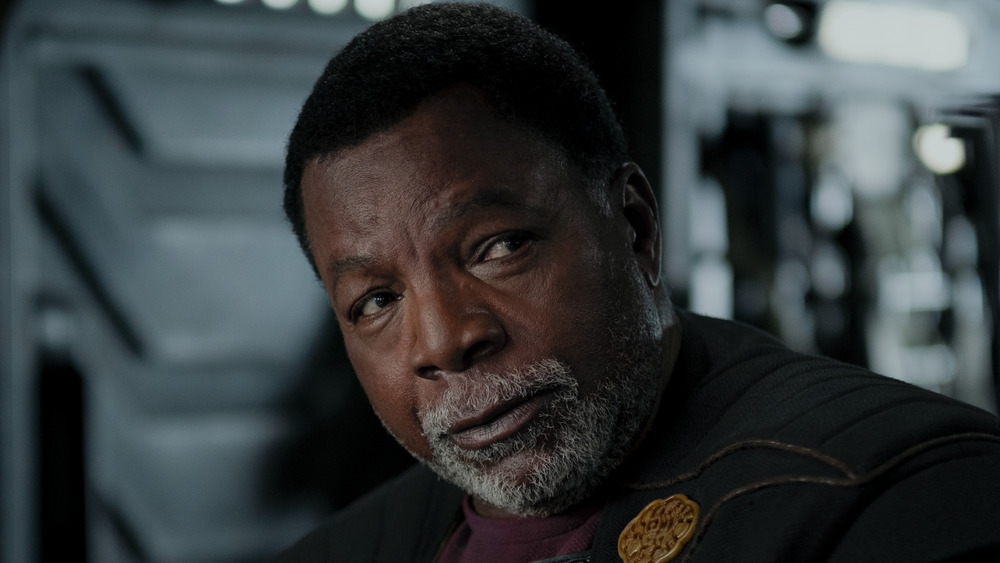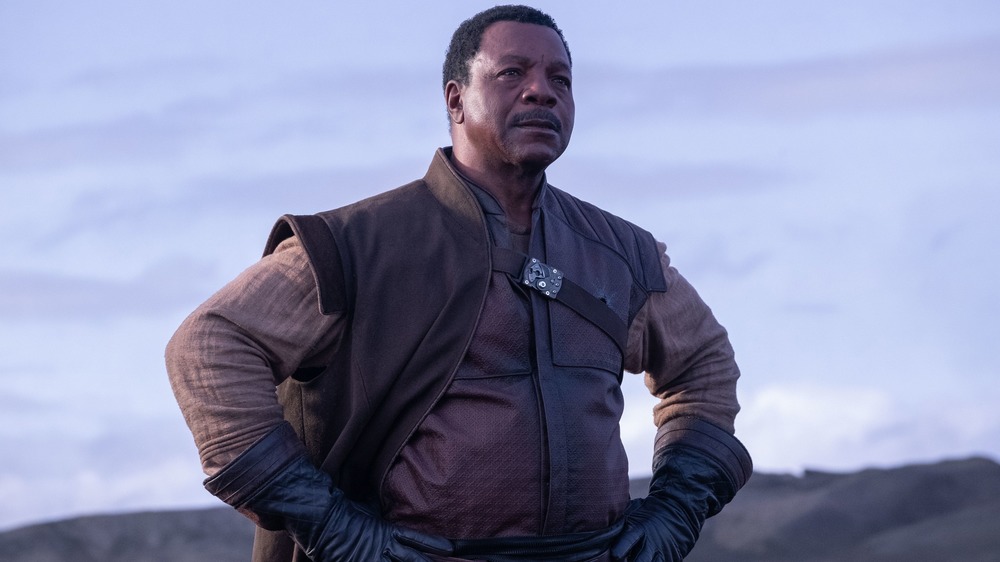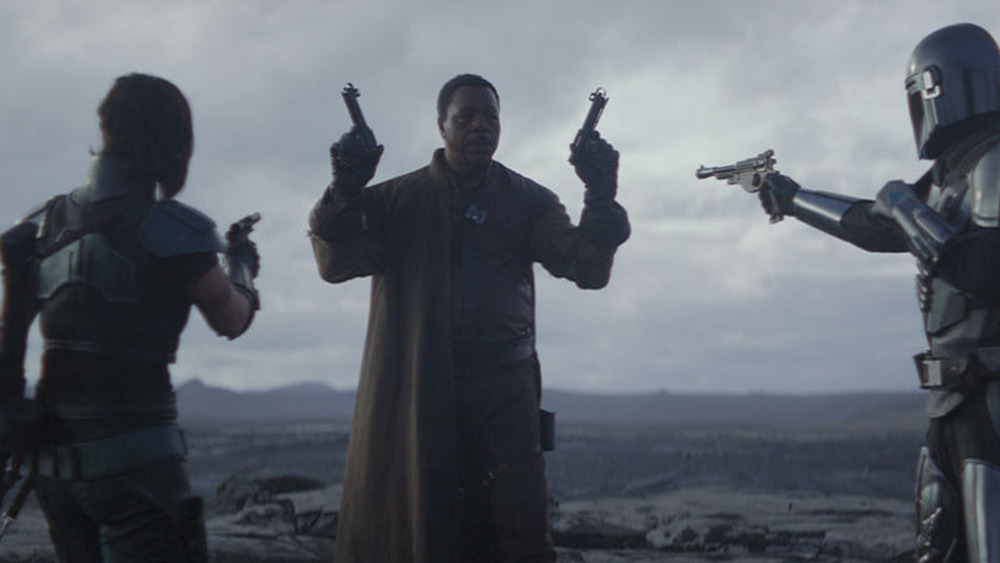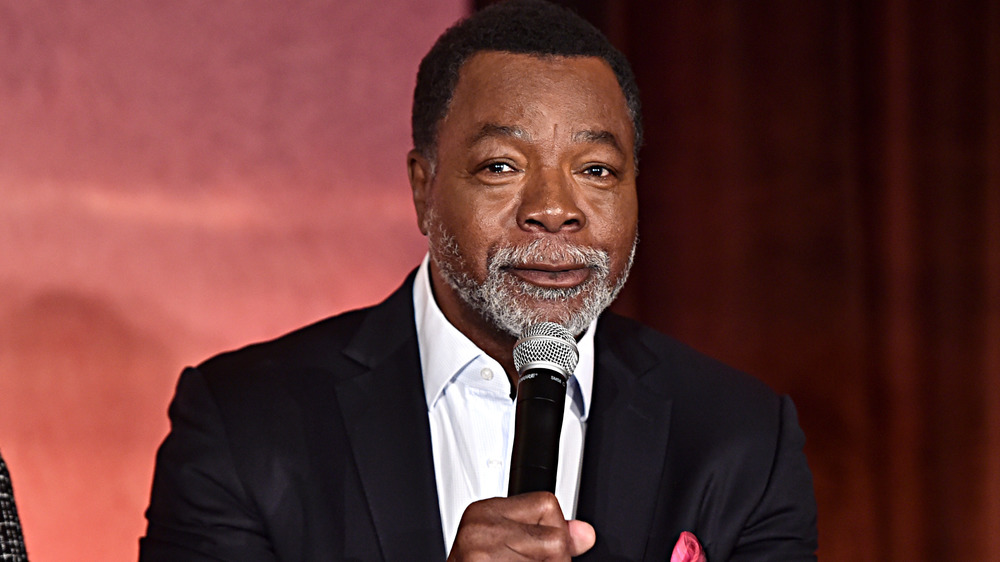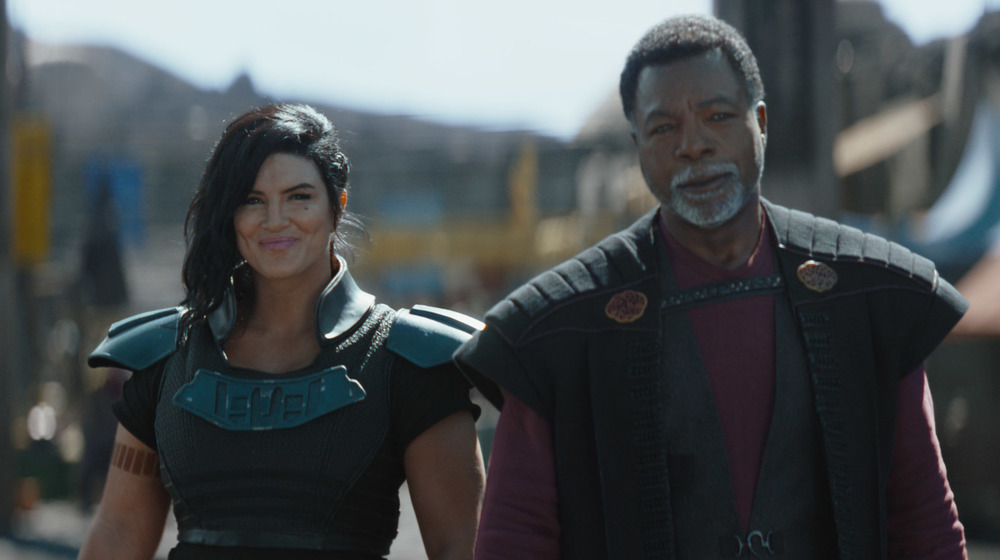Star Wars: The Untold Truth Of Greef Karga
Season one of the ongoing Disney+ Star Wars series The Mandalorian introduced fans to a variety of new characters and locations. One of these characters is none other than Mando's morally ambiguous co-worker, Greef Karga.
Played by veteran actor Carl Weathers, who many film fans know best as Apollo Creed from the Rocky franchise and Colonel Al Dillon from the first Predator film, Karga is introduced in the show's pilot. He's an expeditor in the bounty hunting trade on the planet Nevarro, who goes on to become a major player in the future of the series. Although Weathers' character has yet to be expanded upon in other forms of Star Wars media, there are still many interesting facts and tidbits to learn about Karga that even the most seasoned Star Wars fans may not already know. We're here to explore the mysterious truths and weird history of Greef Karga, from his close brush with death to the times Weathers has worked as both actor and director.
True thespian, better person
Weathers has been acting in Hollywood for over 45 years — yet he was still cautious when accepting a role in The Mandalorian.
Early on in "Cast," an episode of the making-of docuseries Disney Gallery: The Mandalorian, Weathers explains that even though he was very interested in working with producer-showrunner Jon Favreau, he still wanted to know exactly what he was getting into before signing on the dotted line. "When we talked in the very beginning, of course I was interested in working with [Favreau]," Weathers recounts. "I mean, that was first. But I always want to see the script, man. I want to know, 'What am I being asked to do?' 'Cause, you know, people have their agendas or they have their ways of seeing the world ... [as an actor] you're somehow endorsing what someone wants to say about the world." This kind of caution and thoughtfulness is the mark of an experienced actor, and in the end, The Mandalorian passed Weathers' test.
The weight of the helmet
Acting against someone whose face is almost always concealed is quite difficult. Weathers espoused this sentiment during one of The Mandalorian's table read sessions, captured in Disney Gallery: The Mandalorian.
"I found it [challenging]," Weathers muses. "You know, when you're across from somebody, they're throwing all kinds of body language at you ... You can be saying one thing, but [your eyes] tell me something completely different. And what am I responding to ... I've got to adjust for it. And that helmet ... It is flat. There is nothing." So much of acting is, as Weathers details, a collaborative process that takes place in the moment. But when one member of a scene literally has no face, there's a whole lot less for their scene partners to play off of.
Luckily, Weathers is a veteran actor who knows how to work outside the box. "I have to listen so acutely to the voice and hope that voice is gonna cue to what this person is. Not just the words, but what they're really saying under it," he details in the Disney Gallery series. "And it's a challenge. It makes you focus even more and concentrate even more and become even more still, if that's possible." Weathers' Karga shares more scenes with Mando than any other character in season one, except Baby Yoda — he had to find a way to make this work. Happily, he did.
Old-school character, new-school performance
When discussing his character in the "Cast" episode of Disney Gallery: The Mandalorian, Weathers likens Karga to "a combination of John Huston and Orson Welles." For those who don't know, John Huston is famous for writing and directing several landmark films, including The Maltese Falcon, The Treasure of Sierra Madre, and The Asphalt Jungle, while also starring in high-profile movies such as Chinatown and Battle for the Planet of the Apes. Welles, a giant of cinema history, is best known for co-writing, directing, and starring in the groundbreaking 1941 motion picture Citizen Kane. He also directed and starred in several other classic movies, including The Stranger, The Lady from Shanghai, and Touch of Evil.
Whether or not you're familiar with either of these aforementioned men, there is no denying that Karga shares some qualities with both. As Weathers puts it, "There is this largesse about him. There is this commanding sort of presence about him that he doesn't try to do, but that's just who he is. When he walks into a space, not a room, any space, he fills that space."
Un-antagonistic antagonist
While many actors tend to play their villain roles as unabashedly evil, Weathers expresses in Disney Gallery: The Mandalorian that he did not want to fall into that trap with his portrayal of Greef Karga in the first season of The Mandalorian. "You can paint a character as an antagonist, as the bad guy, and I've never approached roles that way, ever," Weathers explains. "I find tremendous flaws in human beings. And at times, those flaws can lead a person astray, lead them to the dark side. So the story of Greef is that he is tempted."
It's interesting to contrast Weathers' description of Karga in season one against the more sinister characters who have emerged since. Karga is definitely not as nefarious as someone like Giancarlo Esposito's Moff Gideon, for example, who is still a member of the Galactic Empire, even though it fell five years before the events of The Mandalorian's first season. Weathers portrays Karga with true nuance, a choice that makes him a fascinating figure on his own, in addition to shedding light on the heroes and villains around him.
Cheating death
Anyone who has seen the third episode of the The Mandalorian, "Chapter 3: The Sin," will know that Karga survives being shot by Mando because of the beskar ingot in his jacket. But believe it or not, that wasn't always supposed to be the case.
Favreau explains near the end of the "Cast" episode of Disney Gallery: The Mandalorian that Karga was initially supposed to be killed off in "The Sin," and that Weathers accepted the role as a favor to Favreau. Of course, things changed, and Karga has ended up playing a much bigger role in the series than Favreau and co-showrunner Dave Filoni initially intended. Given the fact that Weathers is arguably one of the most recognizable names in the season one cast of The Mandalorian, the fact that this character might not have lived past the show's third episode is shocking, to say the least. Just think: If that scenario had come to pass, then we wouldn't have gotten one of the most memorable supporting characters of the series so far.
Alien origins
During the conversation captured in Disney Gallery that details how Karga was originally planned to be killed off in the third episode, Favreau and Filoni also mention that the character was initially conceived of as an alien. In this take on the character, Weathers' face was going to be completely covered in prosthetics.
As Favreau explains, "They did a drawing with Carl with the makeup on ... I said to Carl, 'We can't cover you up.' And he's like, 'I figured as much,'" to which everyone at the table laughs. Weathers elaborates that he initially went with the heavily made-up vision because "there was no reason to argue yet." Sometime after trying the look on, however, he changed his tune. "Okay, why would you do that? Because people are gonna tune in if you got the name," he muses. "Why not have the face?" Although the concept art of this initial take on Karga has yet to be made available to the public, it's still enormously interesting to ponder what it would have been like to not see Weathers' actual face throughout the show.
Carl Weathers, Mandalorian director
Weathers not only portrays Karga in the first two seasons of The Mandalorian, he also directed an episode of season two. Even though Weathers already has plenty of experience directing television, "Chapter 12: The Siege" marks the first time that Weathers has directed a television episode set in the Star Wars universe. Many critics, such as Ben Lindbergh of The Ringer, praised Weathers' direction, saying he "handled the demanding assignment in a way that was worthy of the action hero he is."
In an interview with Empire, Weathers expounded upon the experience. "The challenge for me as a director — and I'm certain the challenge for Jon as a writer-producer — was keeping people engaged, wanting to know what's going to happen next. And when you find out what's really involved here, you finally get to, 'Oh man, this thing is much bigger than we thought.'"
One thing's for sure: Weathers didn't treat this directing gig like he was pushing pencils. He threw himself into the work as whole-heartedly as he does his acting.
